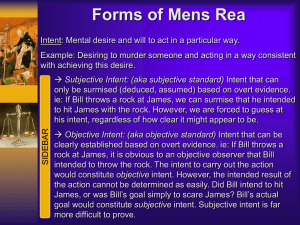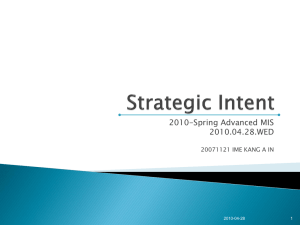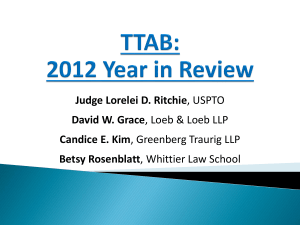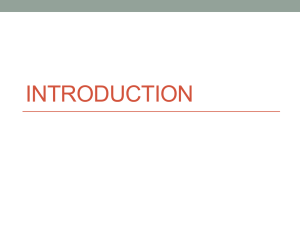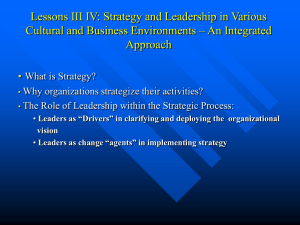The Process of Strategic Management
advertisement
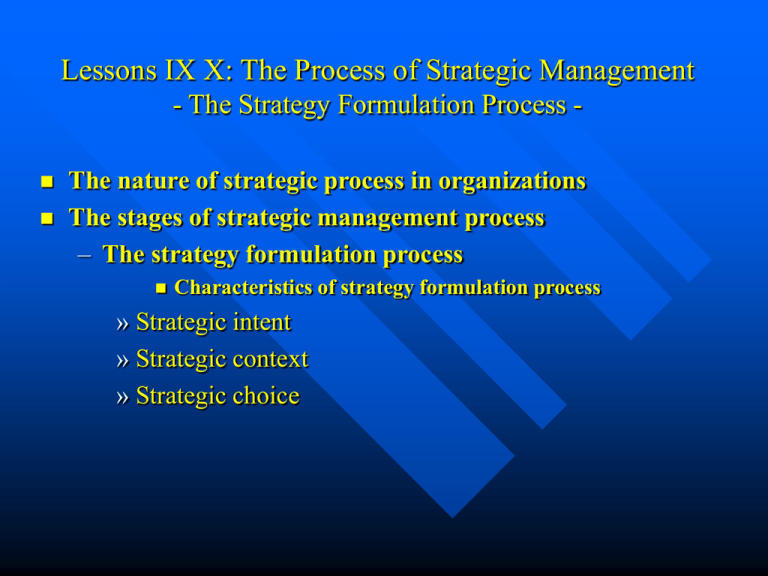
Lessons IX X: The Process of Strategic Management - The Strategy Formulation Process The nature of strategic process in organizations The stages of strategic management process – The strategy formulation process Characteristics of strategy formulation process » Strategic intent » Strategic context » Strategic choice The Nature of Strategic Process in Organizations Henry Mintzberg refers to five types of strategies: “Strategy as plan - a direction, guide, course of action - intention rather than actual; Strategy as ploy - a maneuver intended to outwit a competitor; Strategy as pattern - a consistent pattern of past behavior - realized rather – than intended; Strategy as position - locating of brands, products, or companies within the conceptual framework of consumers or other stakeholders – strategy determined primarily by factors outside the firm; Strategy as perspective - strategy determined primarily by a master strategist.”[i] [i] (Source: Wikipedia – The Free Encyclopedia, (2005) “Strategic Management”. Op. cit.) Thus, there are multiple facets of organizational strategy. The strategy is a continuous process of adjusting organization’s internal resources and capabilities to external, business environment. The nature of strategic process is, also, changeable as the strategy can be regarded in five different ways, according to Mintzberg. The organizational strategy can be seen as positioning, emphasizing the importance of brands and products within the conceptual framework of consumers. This type of strategy is rather influenced by factors outside of the firm. Strategy as plan, on its turn, is rather intentional in its nature, focusing on providing directions, course of actions. Strategy as ploy deals with competition, providing ways of outwitting competitors. Finally, strategy as pattern is less intentional in its nature, being rather focused on past behaviors. Such a strategy reveals the great importance of the cultural environment of a firm as a key factor of its success and legitimates a cultural approach of the firm and even of the strategic management. See, also, Huw Richards, “Mintzberg's 5 Ps for Strategy” in “Decision support tools”, Institute for Manufacturing, University of Cambridge. Available from: http://www.ifm.eng.cam.ac.uk/dstools/paradigm/5pstrat.html Constantinos Markides, also, reexamined the complex nature of strategic planning itself. Strategy is “an on-going, never-ending, integrated process requiring continuous reassessment and reformation.”[i] J. Moncrieff (1999) also refers to strategic planning. “He recognized that strategy is partially deliberate and partially unplanned. The unplanned element comes from two sources: emergent strategies (result from the emergence of opportunities and threats in the environment) and strategies in action (ad hoc actions by many people from all parts of the organization).”[ii] [i] Ibid. [ii] Ibid. The Stages of Strategic Management Process There are three inter-related stages of strategic management process as follows: Strategy Formulation Process Strategy Content Strategy in Action Organizational strategy is seen as a continuing process based on three interrelated stages as follows: Strategy Formulation Process – It is the first stage of strategic process. The purpose of strategy formulation process is about assessing the followings: – Strategic Intent – Any organization should formulate its intentions. “Without an underlying intent, strategy lacks an overall sense of direction and there is no reason to choose one direction rather than another.”[i] – Strategic context – The analysis of both internal and external environment provides a first insight into the real life of the organization. It is the starting point before going further with formulating strategic choices. – Strategic Options – It provides the link to strategic action. It is based on the nexus of potential strategic directions for firm’s business development. [i] Macmillan, Hugh; Tampoe, Mahen. (2000) Strategic Management – Process, Content, and Implementation, New York: Oxford University Press, p. 64 Strategy Content – It is about “strategies that emerge from the process and constitute a blueprint of desirable actions that the organization should take to secure its future.”[i] Strategy in Action – It is the last stage of the entire strategic process. Strategy in Action is about “translating strategy into action”. [i] Ibid. p. 163 The Strategy Formulation Process The strategy formulation process is a structured approach of strategic thinking conceiving the future state of the firm. This process should be “tailored to the current needs of the organization.”[i] The strategy formulation process has several characteristics as follows: The strategy/process considers the company as a whole; There is a long-term approach when formulating the strategic process; Strategic thinking should “address both the relationship of the enterprise with its external and its own capabilities and resources.”[ii] The strategy formulation process has three main “logical elements”: strategic intent, strategic assessment and strategic choice. [i] Ibid. p. 63 [ii] Ibid. p. 63 Strategic Intent “Strategic intent is concerned with the ends and purposes of the enterprise and combines a vision of the future with the intent to make that vision a reality.”[i] Strategic intent is a way of reconciling firm’s end to its means.[ii] Gary Hamel and C.K. Prahalad argue that strategic intent has three attributes as follows: “Sense of Direction”: Strategic intent is a “view of the future conveying a unifying and personalizing sense of direction.”[iii] “Sense of Discovery”: “A strategic intent is differentiated; it implies a competitively unique point of view about the future.”[iv] “Sense of Destiny”: “Strategic intent has an emotional edge to it; it is a goal that employees perceive as inherently worthwhile.”[v] [i] Ibid. p. 70 [ii] According to Hamel, Gary and Prahalad, C.K. Available from: http://www.valuebasedmanagement.net/methods_hamel_prahalad_strategic_intent.html [iii] Ibid. [iv] Ibid. [v] Ibid. The business mission is an “organization's vision translated into written form.”[i] The business mission should contain the following elements: “Purpose: Why the business exist? Values: What management believes in? Standards and behaviors: The rules that guide how the business operates Strategy and Scope: What business and how?”[ii] [i] “Corporate Vision, Mission, Goals and Strategies - Traditional and New Approaches”, Available from: http://www.1000ventures.com/business_guide/crosscuttings/vision_mission_strategy.html [ii] Tutor2u (2005) “Strategic Planning – Mission”, Available from: http://www.tutor2u.net/business/strategy/mission.htm The Elements of a Business Mission Source: Tutor2u (2005) “Strategic Planning – Mission”, Available from: http://www.tutor2u.net/business/strategy/mission.htm Strategic Context The strategic context refers to the analysis of both external and internal environment in which the firm operates. External assessment is concerned with changes in the business environment. Internal assessment is concerned with the organizational resources, i.e. physical resources (e.g. plants, equipments, etc.), unique capabilities, i.e. “capabilities, and competencies of the enterprise and the potential for these to meet future customer needs.”[i] The strategic context is the assessment of the “current position of the enterprise as a whole in its relationship with to the outside world.”[ii] There is a continuous interdependency between the strategic assessment and the following influencing factors: Internal, organizational environment; External, business environment in which the company operates; Strategic intent or the strategic purpose, i.e. organizational mission and vision; Strategic choice or the options made in relation with the strategic intent; Operational results; Triggers: “Occasionally (…) the gap between expectations and achievement requires more fundamental change. The awareness of this gap may act as a trigger for new thinking and new strategies.”[iii] [i] Macmillan, Hugh; Tampoe, Mahen. Op. cit. p. 81 [ii] Ibid. p. 82 [iii] Ibid. p. 83 Formulating strategic options depends on the reality perceived as a result of assessing both internal and external environment. Thus, there are two types of influencing factors as following: The influences of assessing both internal and external environment as well as operational results. The interdependency between the strategic assessment and the strategic choice as well as the strategic intent. Therefore, there are several influencing factors as follows: External Factors: The Business Environment Industry Competitors Internal Factors: Resources Capabilities Operational Results Triggers Strategic Intent Strategic Choice Strategic Choice The strategic choice is the “process of selecting one option for implementation.”[i] “A strategic option is a set of related options (typically combining options for product/markets and resources) that form a potential strategy.”[ii] The chosen strategy is the result of the strategic process where various decision makers within the organization decide on a course of action based on the agreed strategic intent and the situational analysis, i.e. strategic context. [i] Macmillan, Hugh; Tampoe, Mahen. Op. cit. p. 133 [ii] Ibid. p. 133 Results of the Strategy Formulation Process Source: Macmillan, Hugh; Tampoe, Mahen. Op. cit. p. 134 There is a structure for making strategic choices based on formulating various options as following: “Options about products, markets, and services; Options to improve resources and capabilities; Option of method on how to progress.”[i] There are, also, various decision makers involved in the process of formulating strategic choices who use criteria and theoretical frameworks for making strategic choice. Finally, the chosen strategy is the result of a process concerning: Different kinds of options, i.e. options regarding products or services, options for improving resources and capabilities and options on how to progress; Various decision makers implied in the strategic process; Different criteria and theoretical frameworks used for making strategic choices. [i] Ibid. p. 135
